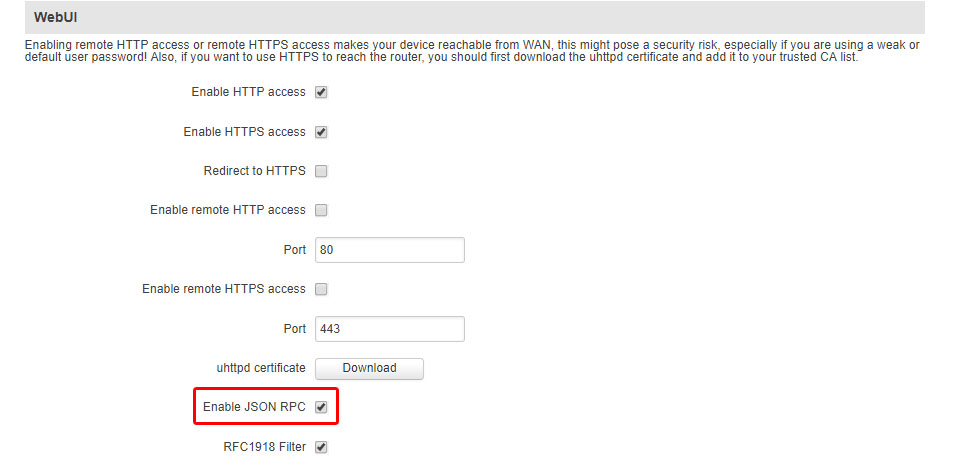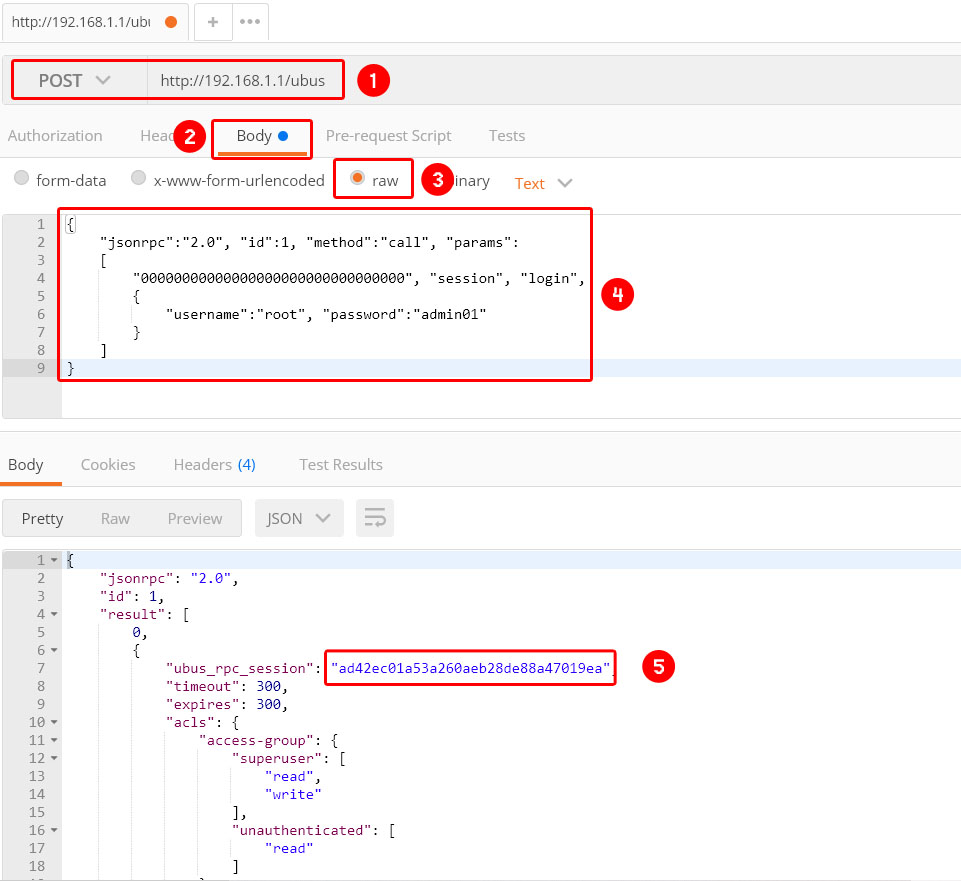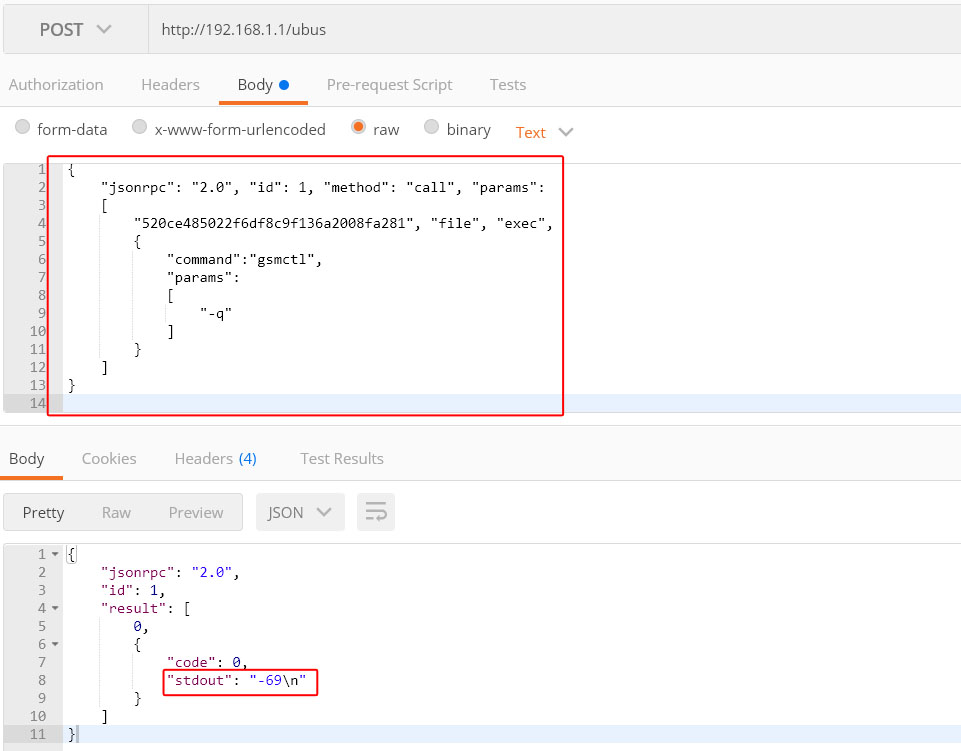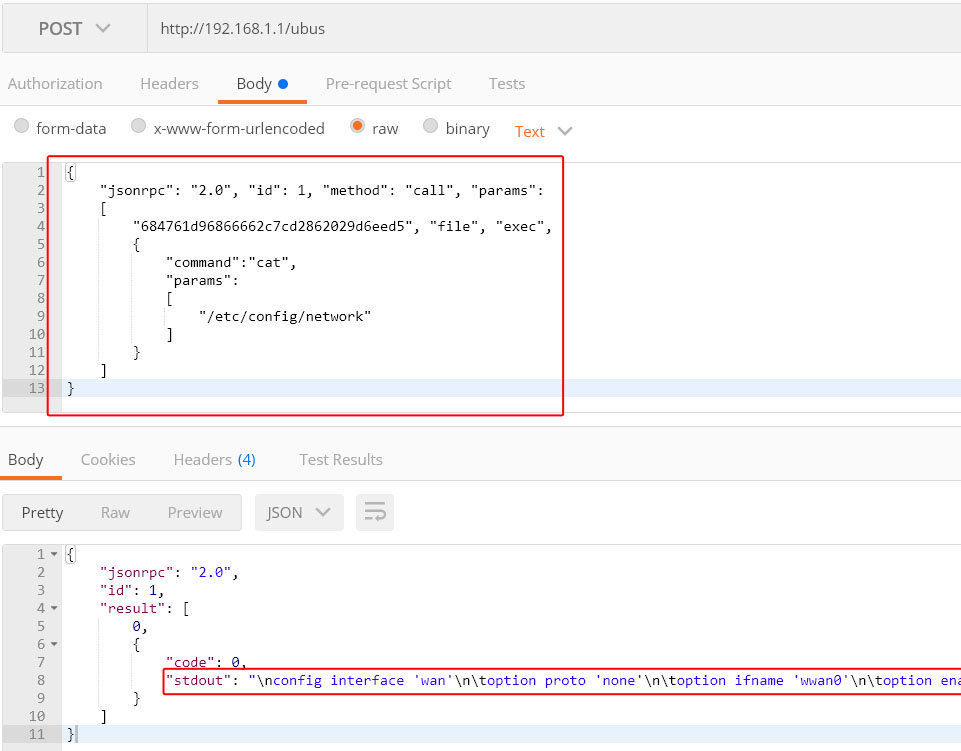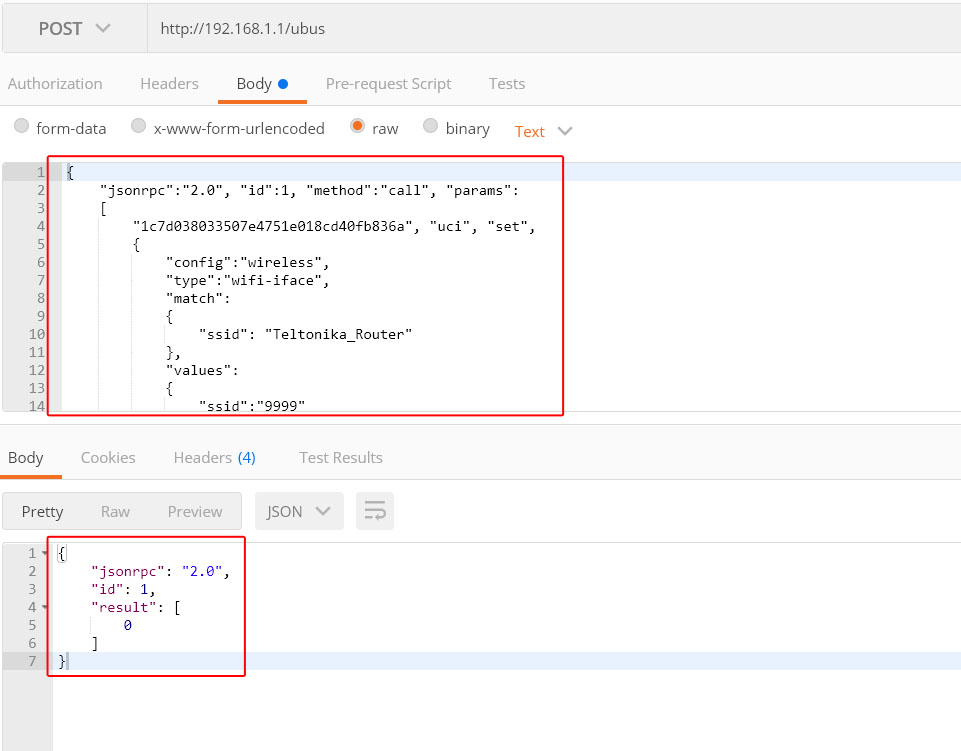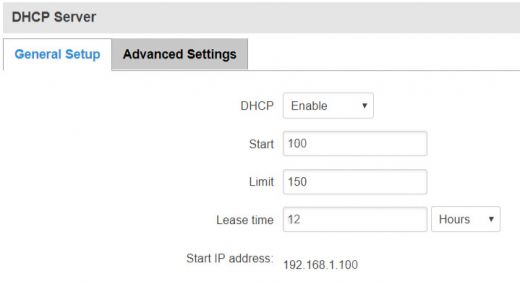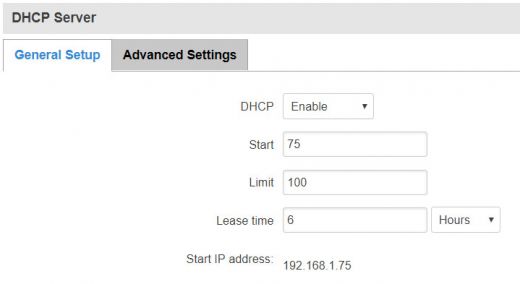Template:Networking rutxxx configuration example JSON RPC windows: Difference between revisions
Oscar.morao (talk | contribs) No edit summary |
Oscar.morao (talk | contribs) No edit summary |
||
| (2 intermediate revisions by the same user not shown) | |||
| Line 13: | Line 13: | ||
* One RUTxxx series router.<br> | * One RUTxxx series router.<br> | ||
'''Configuration scheme:''' | '''Configuration scheme:''' | ||
[[File:{{{file_scheme}}}|border|class=tlt-border | [[File:{{{file_scheme}}}|border|class=tlt-border]] | ||
==Enabling JSON-RPC== | ==Enabling JSON-RPC== | ||
Before anything else, you'll need to make sure JSON-RPC is enabled on your router. JSON-RPC is enabled by default, so if you haven't made any changes to the router's access settings, everything should be in order. Otherwise you can check JSON-RPC status by logging into your router's WebUI and navigating to '''System → Administration → Access Control'''. Look for the ''WebUI'' section; there will be an '''Enable JSON RPC''' field. Make sure it is checked: | Before anything else, you'll need to make sure JSON-RPC is enabled on your router. JSON-RPC is enabled by default, so if you haven't made any changes to the router's access settings, everything should be in order. Otherwise you can check JSON-RPC status by logging into your router's WebUI and navigating to '''System → Administration → Access Control'''. Look for the ''WebUI'' section; there will be an '''Enable JSON RPC''' field. Make sure it is checked: | ||
[[File:WEBUI JSON.jpg|border|class=tlt-border | [[File:WEBUI JSON.jpg|border|class=tlt-border]] | ||
==Using JSON-RPC (Windows)== | ==Using JSON-RPC (Windows)== | ||
| Line 52: | Line 52: | ||
<li>Once you have everything in order, click '''Send''':</li> | <li>Once you have everything in order, click '''Send''':</li> | ||
</ul> | </ul> | ||
[[File:GETTING ID.jpg|border|class=tlt-border | [[File:GETTING ID.jpg|border|class=tlt-border]] | ||
<br> | <br> | ||
<ul> | <ul> | ||
| Line 93: | Line 93: | ||
The test highlighted in red is your Session ID, and highlighted in orange are the command and the parameter. In this example we're using a '''gsmctl -q''' command that returns the router's RSSI (signal strength) value. | The test highlighted in red is your Session ID, and highlighted in orange are the command and the parameter. In this example we're using a '''gsmctl -q''' command that returns the router's RSSI (signal strength) value. | ||
[[File:GETTING RSSI3.jpg|border|class=tlt-border | [[File:GETTING RSSI3.jpg|border|class=tlt-border]] | ||
Look for '''stdout''' in the post response: <span style="color:green">'''"stdout":"-69\n'''</span>". This tells us that the router's current signal strength is <span style="color:green">'''-69 dBm'''</span>. | Look for '''stdout''' in the post response: <span style="color:green">'''"stdout":"-69\n'''</span>". This tells us that the router's current signal strength is <span style="color:green">'''-69 dBm'''</span>. | ||
| Line 117: | Line 117: | ||
Again the command and the parameter are highlighted in orange. In this case the '''cat''' command is used to view the contents of the '''/etc/config/network''' file. The Response is: | Again the command and the parameter are highlighted in orange. In this case the '''cat''' command is used to view the contents of the '''/etc/config/network''' file. The Response is: | ||
[[File:GETTING NETWORK.jpg|border|class=tlt-border | [[File:GETTING NETWORK.jpg|border|class=tlt-border]] | ||
===Setting router parameters=== | ===Setting router parameters=== | ||
| Line 164: | Line 164: | ||
If the issued command was a success, you should see a Response like this:<br> | If the issued command was a success, you should see a Response like this:<br> | ||
[[File:CHANGING SSID.jpg|border|class=tlt-border | [[File:CHANGING SSID.jpg|border|class=tlt-border]] | ||
====UCI COMMIT==== | ====UCI COMMIT==== | ||
| Line 183: | Line 183: | ||
If the commit was successful, you should see the same message as before: | If the commit was successful, you should see the same message as before: | ||
[[File:COMMIT.jpg|border|class=tlt-border | [[File:COMMIT.jpg|border|class=tlt-border]] | ||
====LUCI-RELOAD==== | ====LUCI-RELOAD==== | ||
| Line 199: | Line 199: | ||
} | } | ||
The command itself is highlighted in orange.<br> | The command itself is highlighted in orange.<br> | ||
[[File:LUCI RELOAD.jpg|border|class=tlt-border | [[File:LUCI RELOAD.jpg|border|class=tlt-border]]<br> | ||
====Setting Multiple Parameters==== | ====Setting Multiple Parameters==== | ||
Latest revision as of 14:02, 11 May 2020
Introduction
The information in this page is updated in accordance with the [[Media:{{{fw_version}}}_WEBUI.bin|{{{fw_version}}}]] firmware version.
JSON-RPC is a remote procedure call protocol encoded in JSON. It is a very simple protocol (and very similar to XML-RPC), defining only a few data types and commands. JSON-RPC allows for notifications (data sent to the server that does not require a response) and for multiple calls to be sent to the server which may be answered out of order.
This article provides a guide on how to use JSON-RPC on RUTxxx routers.
Configuration overview and prerequisites
Before we begin, let's overview the configuration that we are attempting to achieve and the prerequisites that make it possible.
Prerequisites:
- A PC for with a HTTP request software.
- An Internet connection. (This example is based in a local configuration, but also can be used via wired WAN or a remote installation with Public IP)
- One RUTxxx series router.
Configuration scheme: [[File:{{{file_scheme}}}|border|class=tlt-border]]
Enabling JSON-RPC
Before anything else, you'll need to make sure JSON-RPC is enabled on your router. JSON-RPC is enabled by default, so if you haven't made any changes to the router's access settings, everything should be in order. Otherwise you can check JSON-RPC status by logging into your router's WebUI and navigating to System → Administration → Access Control. Look for the WebUI section; there will be an Enable JSON RPC field. Make sure it is checked:
Using JSON-RPC (Windows)
This section describes how to use JSON-RPC with a Windows operating system. If you're using a Linux OS, jump to this section of the guide: [[{{{link}}}|JSON-RPC with Linux]]
HTTP POST
To login to the router via JSON-RPC you will need software capable of sending HTTP POST requests to the router. The simplest solution is to install an extension similar to Chrome "Postman" (download link here).
If you're using Firefox you can use "RESTClient" (download link here).Once you've installed the add-on, Click it to launch it:
Obtaining a session ID
First, you must obtain a Session ID. In order to do so, you must send a HTTP POST request to the router asking for it.
- Enter the router's IP address into the URL field http://192.168.1.1/ubus (use LAN IP for local access, WAN IP for remote access).
- Change the orange code fields with router's username and password (Or change it into the Postman User Auth. field.)
- Then paste the following command into the Body or Content to send field:
{
"jsonrpc":"2.0", "id":1, "method":"call", "params":
[
"00000000000000000000000000000000", "session", "login",
{
"username":"root", "password":"admin01"
}
]
}
The section highlighted in orange is the router's admin password which by default is admin01. Replace this part with your own router's password.
- Once you have everything in order, click Send:
-
Here's how the response should look like (The Session ID is shown in the sixth red rectangle):
- Copy the Session ID since you'll be needing it when issuing other commands to the router.
NOTE: if later on your commands stop working and you get a Response like this:
{
"jsonrpc": "2.0",
"id": 1,
"error": {
"code": -32002,
"message": "Access denied"
}
}
It probably means that your Session ID has expired so you'll need to ask for a new one. A Session ID expires after 300 seconds (5 minutes).
Getting router parameters
Now that you have obtained a Session ID, you can issue commands to the router. Lets start with commands that return information about the router.
Getting RSSI
{
"jsonrpc": "2.0", "id": 1, "method": "call", "params":
[
"bde01a2da4a6f4a515bb9466f90bc58a", "file", "exec",
{
"command":"gsmctl",
"params":
[
"-q"
]
}
]
}
The test highlighted in red is your Session ID, and highlighted in orange are the command and the parameter. In this example we're using a gsmctl -q command that returns the router's RSSI (signal strength) value.
Look for stdout in the post response: "stdout":"-69\n". This tells us that the router's current signal strength is -69 dBm.
Getting Network Config
You can issue many SSH commands in a similar manner. For example, if you wish to check the network the command to do so would be:
{
"jsonrpc": "2.0", "id": 1, "method": "call", "params":
[
"a74c8e07646f0da2bfddce35bf3de1f3", "file", "exec",
{
"command":"cat",
"params":
[
"/etc/config/network"
]
}
]
}
Again the command and the parameter are highlighted in orange. In this case the cat command is used to view the contents of the /etc/config/network file. The Response is:
Setting router parameters
To set parameters, is necessary to use three commands, they are set, commit and luci-reload
- The First one is used to set router parameters
- The second one is used to commit the changes from RAM to flash memory
- The third one is used to the changes take effect
We'll not go into detail on UCI commands in this article, but you can check out our UCI command usage guide for detailed examples.
UCI SET
The uci set command is used to set router parameters.
As an example, lets try to change the router's WiFi SSID. The command to do so looks like this:
{
"jsonrpc":"2.0", "id":1, "method":"call", "params":
[
"9704f676709d9dedc98d7718c4e3e7d2", "uci", "set",
{
"config":"wireless",
"type":"wifi-iface",
"match":
{
"ssid": "Teltonika_Router"
},
"values":
{
"ssid":"9999"
}
}
]
}
- The sections highlighted in orange describes the config file's name and section. (In this case, wireless config and wifi-iface section).
- Highlighted in red is the option of the config section that you wish to change. (In this case, the router's SSID.)
- Finally, highlighted in green is the value that will replace the old value. (In this case, it change the router's SSID to 9999.)
- Note: You should be sure that all the fields are correctly written
If the issued command was a success, you should see a Response like this:
UCI COMMIT
When you apply changes using uci set, you're only changing a copy of the file that is located in the router's RAM memory. In order for the changes to take place you'll need to issue a uci commit command that will commit the changes from RAM to flash memory. Continuing from the example above, lets commit the Wireless SSID changes. The JSON-RPC command to do so looks like this:
{
"jsonrpc":"2.0", "id":1, "method":"call", "params":
[
"9704f676709d9dedc98d7718c4e3e7d2", "uci", "commit",
{
"config":"wireless"
}
]
}
If the commit was successful, you should see the same message as before:
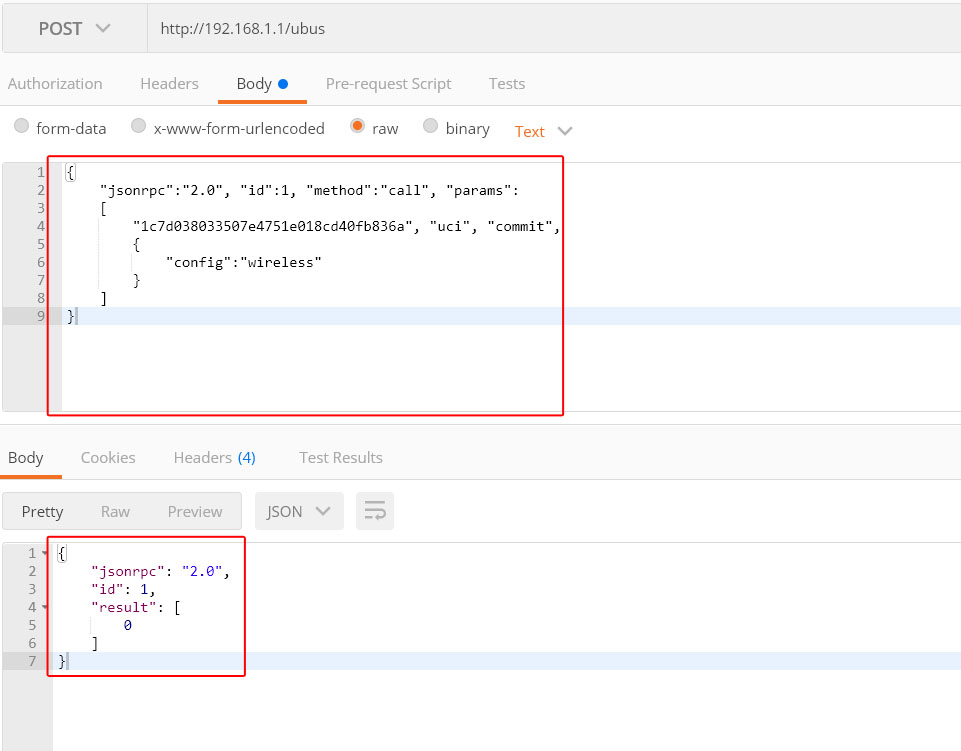
LUCI-RELOAD
The last step to take in order for the changes to take effect is the luci-reload command which restarts all of the router's services. The luci-reload command looks like this:
{
"jsonrpc": "2.0", "id": 1, "method": "call", "params":
[
"428a9fa57f1a391db0bd1b865fa16bb5", "file", "exec",
{
"command": "luci-reload"
}
]
}
The command itself is highlighted in orange.
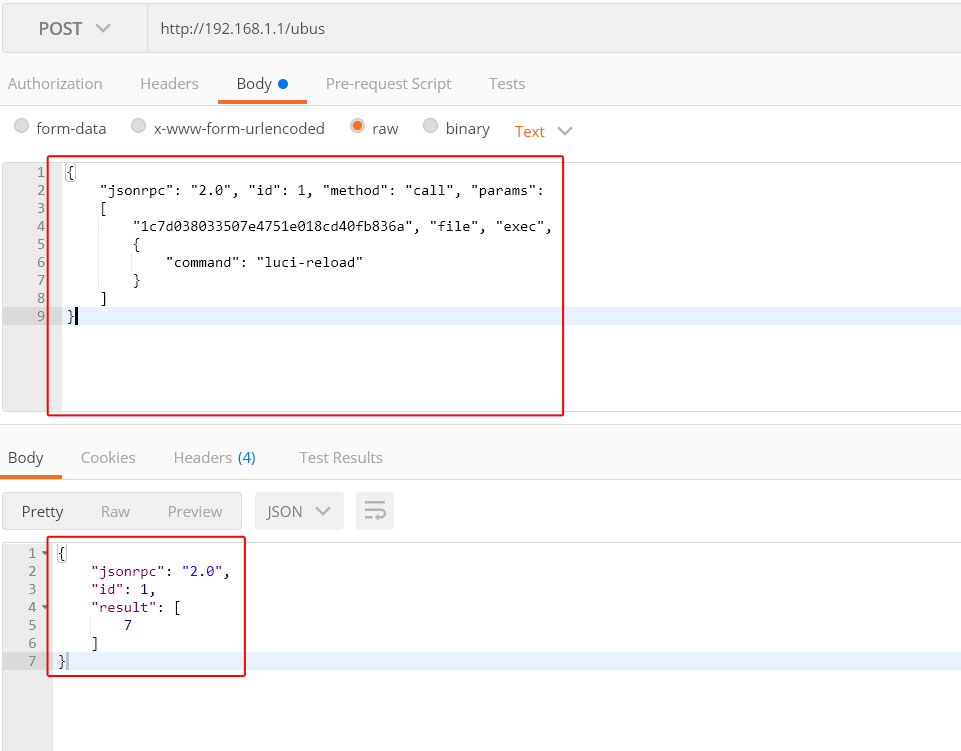
Setting Multiple Parameters
This next example describes how to set multiple parameters in a single config file, in this case, changes the default DHCP server values with custom ones:
{
"jsonrpc":"2.0", "id":1, "method":"call", "params":
[
"558a9b03c940e52f373f8c02498952e3", "uci", "set",
{
"config":"dhcp", "type":"dhcp", "match":
{
"start":"100",
"limit":"150",
"leasetime":"12h"
},
"values":
{
"start":"75",
"limit":"100",
"leasetime":"6h"
}
}
]
}
The command above will change the router's DHCP Server's current Start address, Address limit and Lease time values (highlighted in orange) to custom values provided in the "values" section of the command (highlighted in green).
Note: Remember always to use the commands in the order (set, commit, luci-reload)

